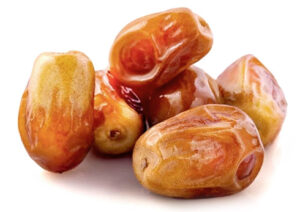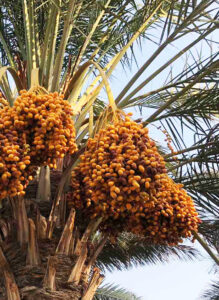Sayer dates are a variety of date fruit that are grown in many regions of Iran, including Khuzestan, Bushehr, Fars, and Kerman provinces. They are known for their sweet taste, soft texture, and high nutritional value. Here are some key facts about Sayer dates that do not include sorting, harvesting, and geography:
1. Appearance: Sayer dates are medium-sized and oval-shaped, with a dark brown to black color. They have a wrinkled texture and are often referred to as "dry" dates.
2. Taste: Sayer dates have a sweet, caramel-like flavor with a slightly nutty taste. They are often used in baking and cooking, as well as eaten as a snack.
3. Nutritional value: Sayer dates are a good source of fiber, potassium, and magnesium. They also contain vitamins B6 and K, as well as antioxidants.
4. Shelf life: Sayer dates have a relatively long shelf life, especially when stored properly. They can be kept for several months at room temperature, or up to a year in the refrigerator or freezer.
5. Uses: Sayer dates are used in a variety of ways, including as a sweetener in desserts and baked goods, in energy bars and snacks, and in savory dishes such as stews and tagines.
Overall, Sayer dates are a popular variety of date fruit that are enjoyed for their sweet taste, soft texture, and nutritional value. They are versatile and can be used in a variety of ways in cooking and baking.
The Geography of Sayer Date
The Sayer date is a variety of date fruit that is primarily grown in the southern regions of Iran, including the provinces of Khuzestan, Bushehr, Fars, and Kerman. These regions have a hot and dry climate, which is ideal for growing dates. The soil in these areas is also well-suited for date cultivation, with a high mineral content and good drainage.
Khuzestan province is the largest producer of Sayer dates in Iran, accounting for around 70% of the total production. The city of Shadegan, located in Khuzestan, is particularly known for its high-quality Sayer dates. Bushehr and Fars provinces also produce significant amounts of Sayer dates, while Kerman is known for its production of other date varieties.
The geography of these regions plays an important role in the cultivation of Sayer dates. The hot and dry climate helps to prevent diseases and pests that can affect the trees, while also promoting the growth of the fruit. The soil in these areas is also well-suited for date cultivation, with a high mineral content and good drainage. The farmers in these regions use traditional methods of irrigation, including qanats (underground water channels) and wells, to provide water to the trees.
Overall, the geography of the southern regions of Iran plays a crucial role in the cultivation of Sayer dates. The climate, soil, and traditional farming methods all contribute to the high quality and unique taste of this variety of date fruit.
Properties of Sayer Dates
Sayer dates are a popular variety of date fruit that are known for their sweet taste and soft texture. They are primarily grown in the southern regions of Iran, including the provinces of Khuzestan, Bushehr, Fars, and Kerman. Here are some of the key properties of Sayer dates:
1. Nutritional value: Sayer dates are a good source of fiber, potassium, and magnesium. They also contain vitamins B6 and K, as well as antioxidants. They are a healthy and nutritious snack that can provide energy and help to regulate digestion.
2. Taste and texture: Sayer dates have a sweet, caramel-like flavor with a slightly nutty taste. They are soft and chewy, with a wrinkled texture. They are often used in baking and cooking, as well as eaten as a snack.
3. Shelf life: Sayer dates have a relatively long shelf life, especially when stored properly. They can be kept for several months at room temperature, or up to a year in the refrigerator or freezer.
4. Uses: Sayer dates are used in a variety of ways, including as a sweetener in desserts and baked goods, in energy bars and snacks, and in savory dishes such as stews and tagines. They can also be eaten on their own as a healthy and satisfying snack.
5. Cultivation: Sayer dates are primarily grown in the southern regions of Iran, where the climate and soil are well-suited for date cultivation. The farmers in these regions use traditional methods of irrigation, including qanats (underground water channels) and wells, to provide water to the trees.
Overall, Sayer dates are a high-quality and nutritious variety of date fruit that are enjoyed for their sweet taste, soft texture, and versatility in cooking and baking. They are an important agricultural product in the southern regions of Iran and are highly valued for their unique properties.
Harvesting Season of Sayer Dates
The harvesting season of Sayer dates typically begins in late August or early September and lasts for about one month. The exact timing of the harvest can vary depending on the region and the weather conditions during the growing season.
During the harvesting season, the date palms are climbed using ladders or ropes, and the clusters of dates are carefully cut from the trees using sharp knives or shears. The dates are then collected in baskets or crates and transported to the packing facilities for further processing.
The harvesting process requires careful attention to detail, as the dates must be harvested at the right time to ensure optimal quality and flavor. If the dates are harvested too early, they may not be fully ripe and may not have developed their characteristic sweetness. If they are harvested too late, they may become overripe and lose their texture and flavor.
Once the dates have been harvested, they are sorted, cleaned, and packaged for distribution. The sorting process involves separating the dates by size and quality, and removing any damaged or discolored fruit. The dates are then washed and dried before being packaged in boxes or bags.
Overall, the harvesting season of Sayer dates is a crucial time for the farmers and producers who rely on this crop for their livelihood. By carefully harvesting and processing the dates, they can ensure that the fruit is of high quality and can be enjoyed by consumers around the world.
Sorting of Sayer Dates
Sorting is an important step in the processing of Sayer dates, which involves separating the fruit into different categories based on their size, color, and quality. The sorting process is usually done by hand, with workers carefully inspecting each date and sorting them into different grades.
Here are some of the key steps involved in the sorting of Sayer dates:
1. Inspection: The first step in the sorting process is to inspect each date for any defects, such as cracks, bruises, or discoloration. Dates that are damaged or discolored are removed from the batch and set aside for further processing.
2. Size grading: Once the defective dates have been removed, the remaining fruit is sorted into different grades based on their size. This is usually done using a series of screens or sieves that separate the dates by size.
3. Color grading: After the dates have been sorted by size, they are then sorted by color. This involves separating the fruit into different categories based on their shade of brown or black.
4. Quality grading: The final step in the sorting process is to grade the dates based on their overall quality. This involves inspecting the fruit for any signs of insect damage, mold, or other defects. Dates that meet the highest quality standards are packaged separately from those that are of lower quality.
Once the sorting process is complete, the dates are cleaned and packaged for distribution. The sorting process helps to ensure that only the highest quality dates are sold to consumers, and that the fruit is consistent in size, color, and flavor.
Packaging of Sayer Dates
Packaging of Sayer dates is an important aspect of their processing, which involves carefully preparing the fruit for distribution to consumers. The packaging is designed to protect the dates during transport, maintain their quality and freshness, and provide important information to consumers. Here are some details about the packaging of Sayer dates:
1. Types of packaging: Sayer dates can be packaged in a variety of materials, including boxes, bags, and plastic containers. The choice of packaging material depends on a variety of factors, including the size and quantity of the dates, the intended market, and the desired shelf life.
2. Box packaging: Sayer dates are often packaged in cardboard boxes, which can hold several kilograms of fruit. The boxes are designed to protect the dates during transport and storage, and are often labeled with important information such as the date of harvest, the grade of the fruit, and the country of origin.
3. Bag packaging: Sayer dates can also be packaged in plastic bags, which are often used for smaller quantities of fruit. The bags are designed to protect the dates from moisture and contamination, and are often resealable to maintain the freshness of the fruit.
4. Labeling: Once the dates have been packaged, they are usually labeled with important information such as the date of harvest, the grade of the fruit, and the country of origin. This information helps consumers to make informed purchasing decisions and ensures that the fruit meets regulatory requirements.
5. Storage and transport: After the dates have been packaged and labeled, they are stored in a cool, dry place to maintain their quality and freshness. They are then transported to markets and retailers around the world, where they are sold to consumers.
Overall, packaging is an important step in the processing of Sayer dates, which helps to ensure that the fruit is of high quality, safe for consumption, and meets the needs of consumers and retailers. Proper packaging helps to protect the dates during transport and storage, and ensures that they remain fresh and delicious for as long as possible.
Transporting of Sayer Dates
Transporting Sayer dates requires careful attention to temperature and humidity control to ensure that the fruit arrives at its destination in good condition. Here are some details about transporting Sayer dates with regards to temperature and humidity:
1. Temperature control: Sayer dates are sensitive to temperature and need to be transported in a controlled environment. The ideal temperature for transporting Sayer dates is between 0°C to 5°C (32°F to 41°F). Temperatures above this range can cause the dates to spoil, while temperatures below this range can cause the fruit to freeze and become damaged.
2. Humidity control: Sayer dates also require a certain level of humidity during transport. The ideal humidity level for transporting Sayer dates is between 60% to 70%. This helps to prevent the fruit from drying out and becoming hard.
3. Refrigerated trucks and containers: To maintain the temperature and humidity levels during transport, Sayer dates are often transported in refrigerated trucks or containers. These vehicles are equipped with temperature and humidity control systems that ensure that the fruit remains fresh and of good quality.
4. Monitoring: During transport, the temperature and humidity levels are monitored closely to ensure that they remain within the ideal range. Temperature and humidity sensors are installed in the trucks or containers, and the data is transmitted to a monitoring system. If the temperature or humidity levels fall outside the ideal range, an alarm is triggered, and corrective action is taken.
5. Handling: Sayer dates are delicate and need to be handled with care during transportation. The fruit needs to be protected from impacts, vibrations, and pressure to prevent damage. Proper handling can help to maintain the quality of the fruit and prevent spoilage.
Overall, transporting Sayer dates requires careful attention to temperature and humidity control to ensure that the fruit arrives at its destination in good condition. The fruit needs to be transported in a controlled environment and monitored closely to maintain the ideal temperature and humidity levels. Proper handling during transportation can also help to maintain the quality of the fruit and prevent spoilage.

